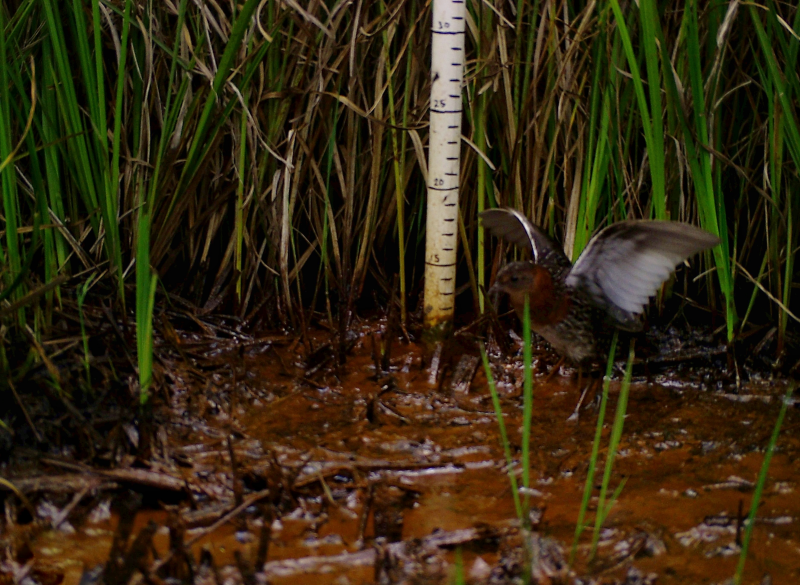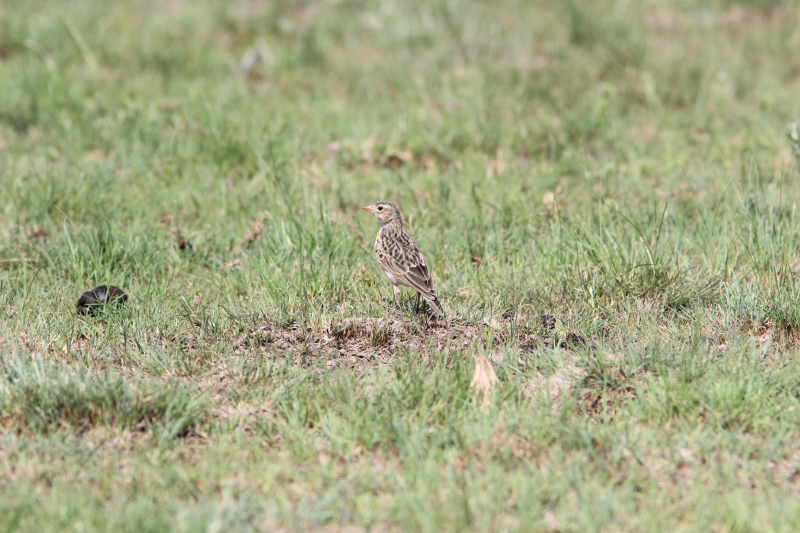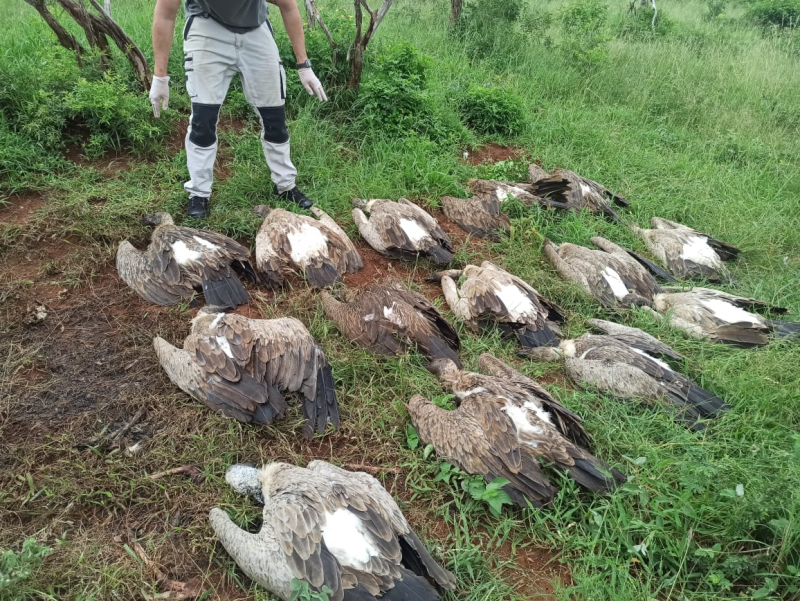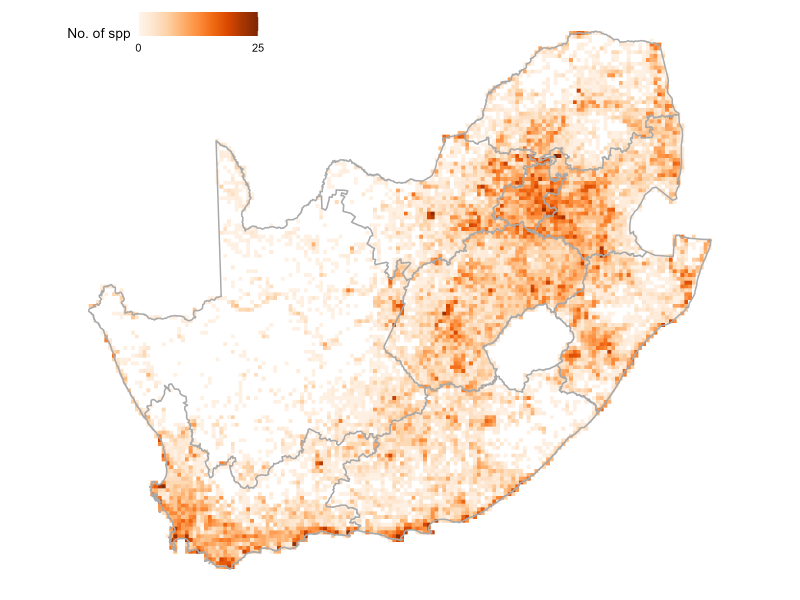
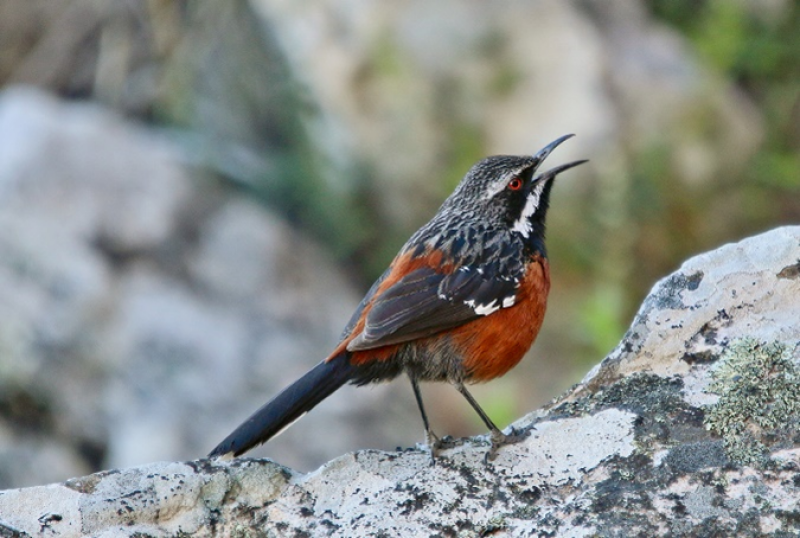
of 728 taxa assessed are
Threatened
of 652 taxa assessed are
Well Protected
of 652 taxa assessed are
Poorly Protected
Key findings
In the current assessment, 728 taxa have been evaluated, and 26 of these species are endemic to South Africa, Eswatini, and Lesotho.
Nearly 13% (93) of assessed birds are threatened with extinction, with another 7% (54) assessed as Near Threatened.
Thirty-four percent (9 out of 26) of South Africa’s endemic birds are threatened with extinction, placing full responsibility for their protection on the Republic of South Africa.
Birds are becoming increasingly threatened with extinction, with 39 species uplisted to higher threat categories. While eight species were downlisted, showing some improvement in status.
The main pressures driving change in threat status have remained similar to those driving change in the previous assessments, but in this assessment, the plight of waterbirds has been highlighted, with many water birds being uplisted to a higher category of threat.
Freshwater health needs improvement to protect these species; however, it will require strong political commitment and resources. Many freshwater species are congregatory and thus vulnerable to disease outbreaks, making greater protection of key sites essential to slow declines. At the same time, urban freshwater systems offer valuable opportunities for citizen-led restoration and monitoring.
Using a subpopulation method based on proximal protected areas, a large proportion of birds are Well protected within the South African Protected Area Network (86% - 561 species); with only 7% Poorly Protected and in need of intervention to increase their protection level.
When protection level is assessed using a Minimum Conservation Population (MCP) approach that incorporates species-specific abundance thresholds, protection levels are far lower: only 10% of Red Listed species are Well Protected, while the vast majority (90%) remain inadequately protected despite occurring within the protected area network.

Threat status, trends and pressures
- Threat status
South Africa, Lesotho, and Eswatini host a rich assemblage of bird species, many of which are endemic and have drawn global conservation interest. The region has a long history of publishing lists of threatened bird species, with Red Data Books published in 1976, 1984, 2000, and most recently in 2015, when 132 species were listed with an IUCN threat category greater than Least Concern. Given growing evidence of shifting population trends and continued anthropogenic pressures reshaping habitats, an updated Regional Red List assessment was conducted by BirdLife South Africa from late 2021 to early 2025, with contributions from 138 species experts (see approach section below for further details on how the assessment was conducted).
A total of 25 species were uplisted from LC or Not Evaluated to higher threat categories due to deterioration in status. Most of these (n = 16) were waterbirds, followed by terrestrial (n = 6), seabirds (n = 2) and a raptor species (n = 1).

| Taxon | Critically Endangered | Endangered | Vulnerable | Near Threatened | Least Concern | Total |
|---|---|---|---|---|---|---|
| Overall birds | 11 | 33 | 49 | 54 | 580 | 727 |
| Endemic birds | 2 | 3 | 4 | 8 | 9 | 26 |
- Trends
The trend in species status over time was measured using the globally recognized indicator, the IUCN Red List Index of species (RLIs)1. The RLIs are calculated based on genuine changes in Red List categories over time. The RLIs value ranges from 0 to 1, and the lower the value the faster the taxonomic group is heading towards extinction – i.e. if the value is 1, all taxa are Least Concern and if the value is 0, all taxa are extinct. The Red List Index of birds was calculated for all taxa that have been reassessed (n = 729).
Through calculating the RLI, it was found that many species have shifted in their threat levels over the last decade. Results indicate that the average RLI score across 729 species decreased between 2015 and 2025, evidence that the overall extinction risk has worsened. 147 species had a threat status higher than Least Concern for 2025.
Although 131 species showed no change in status, 39 deteriorated (moving into higher risk categories) and 8 improved. The analysis highlights that habitat degradation, invasive species, powerline collisions, climate change, and fisheries impacts remain pressing conservation issues. Targeting these threats is essential, especially for species newly classified as Vulnerable or Endangered.
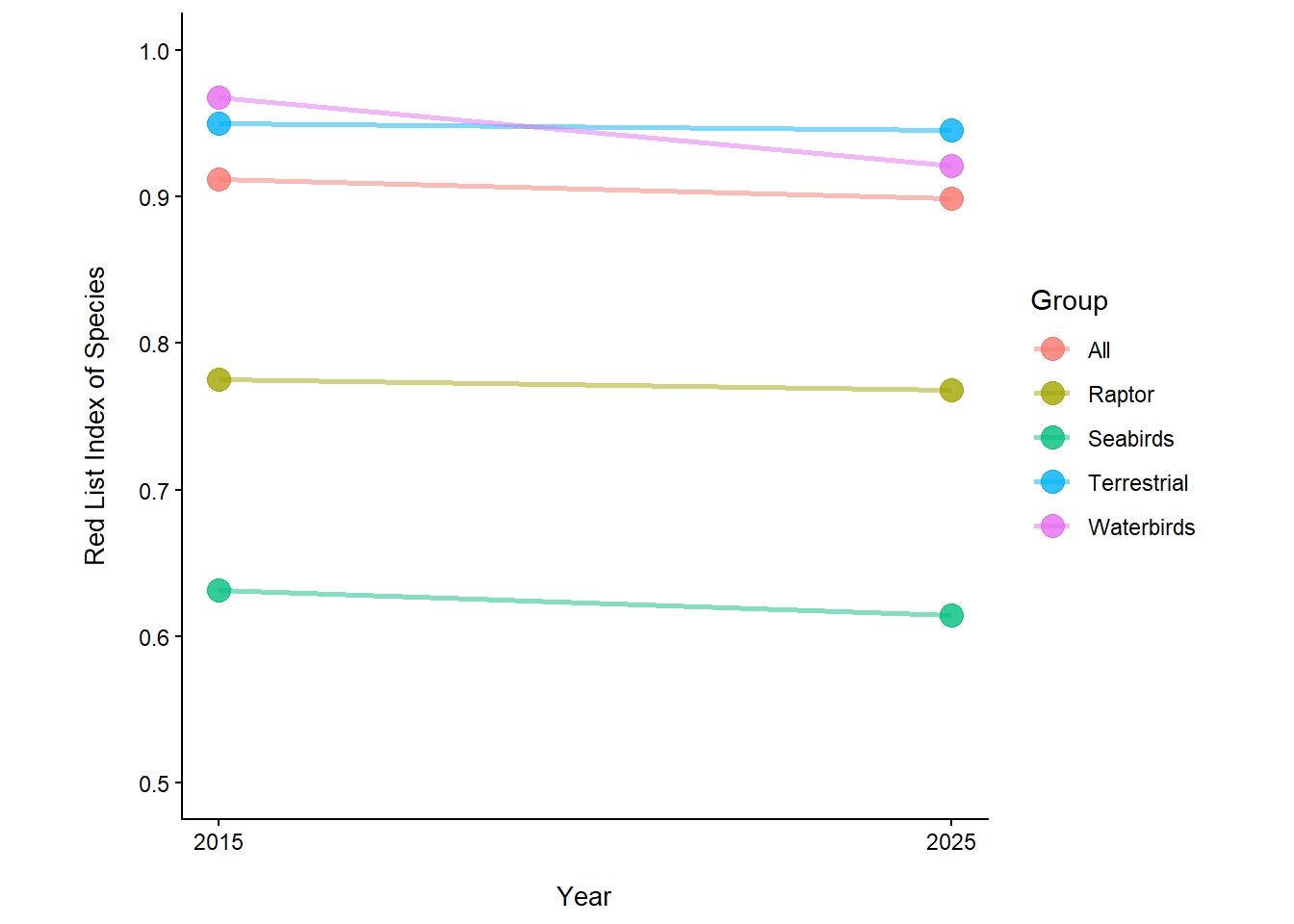
| Taxon | Change in status (2015 to 2025) | Endemism | Direction of change | Reason for change |
|---|---|---|---|---|
| Forest Buzzard* | LC to NT | Endemic | Uplist | Agriculture and aquaculture |
| Blue Crane | NT to VU | Non-endemic | Uplist | Agriculture and aquaculture, Climate change |
| Wattled Crane | CR to EN | Non-endemic | Downlist | Population increasing |
| African Darter | LC to NT | Non-endemic | Uplist | Natural system modification, pollution |
| Knob-billed Duck | LC to NT | Non-endemic | Uplist | Natural system modification |
| Maccoa Duck | NT to VU | Non-endemic | Uplist | Natural system modification, pollution, disease |
| White-backed Duck | LC to NT | Non-endemic | Uplist | Disease, pollution |
| Yellow-billed Duck | LC to NT | Non-endemic | Uplist | Natural system modification, pollution |
| Steppe Eagle | VU to EN | Non-endemic | Uplist | Agriculture and aquaculture, persecution |
| Great Egret | LC to NT | Non-endemic | Uplist | Natural system modification, pollution |
| Yellow-billed Egret | LC to NT | Non-endemic | Uplist | Natural system modification, pollution |
| Lanner Falcon | VUto NT | Non-endemic | Downlist | Improved knowledge |
| Red-footed Falcon | NT to VU | Non-endemic | Uplist | Agriculture and aquaculture, persecution |
| Lesser Flamingo | NT to VU | Non-endemic | Uplist | Natural system modification, pollution, climate change |
| Great-crested Grebe | NT to VU | Non-endemic | Uplist | Natural system modification, pollution, climate change |
| Hamerkop | LC to NT | Non-endemic | Uplist | Natural system modification, climate change |
| Black-crowned Night Heron | LC to NT | Non-endemic | Uplist | Natural system modification, pollution |
| Southern Bald Ibis* | VU to NT | Endemic | Downlist | Targeted conservation action means population increasing |
| Lesser Kestrel | NT to VU | Non-endemic | Uplist | Climate change, persecution, agriculture and aquaculture |
| Half-collared Kingfisher | NT to VU | Non-endemic | Uplist | Climate change, natural system modification, pollution |
| Black-winged Kite | LC to NT | Non-endemic | Uplist | Ecosystem modification |
| Red Knot | LC to NT | Non-endemic | Uplist | Climate change, residential and commercial development, pollution |
| Blue Korhaan* | LC to VU | Endemic | Uplist | Energy production and mining, agriculture and aquaculture |
| Botha’s Lark* | EN to CR | Endemic | Uplist | Agriculture and aquaculture, climate change, human intrusion and disturbance |
| Melodious Lark | LC to NT | Non-endemic | Uplist | Natural system modification, climate change, agriculture and aquaculture |
| Marsh Owl | LC to NT | Non-endemic | Uplist | Agriculture and aquaculture, natural system modification, transportation and service corridors |
| Chestnut-banded Plover | NT to VU | Non-endemic | Uplist | Residential and commercial development, natural system modification, pollution |
| Grey Plover | LC to NT | Non-endemic | Uplist | Climate change |
| Kittlitz’s Plover | LC to NT | Non-endemic | Uplist | Residential and commercial development, natural system modification, pollution |
| Sanderling | LC to NT | Non-endemic | Uplist | Residential and commercial development, natural system modification, climate change |
| Curlew Sandpiper | NT to VU | Non-endemic | Uplist | Climate change, human intrusion and disturbance, residential and commercial development |
| Cape Shoveler | LC to NT | Non-endemic | Uplist | Ecosystem modification, biological resource use, disease |
| Abdim’s Stork | NT to LC | Non-endemic | Downlist | Improved knowledge |
| Black Stork | VU to EN | Non-endemic | Uplist | Natural system modification, climate change, transportation and service corridors |
| Red-billed Teal | LC to NT | Non-endemic | Uplist | Natural system modification, pollution, disease |
| Orange Ground Thrush | NT to VU | Non-endemic | Uplist | Agriculture and aquaculture, natural system modification |
| Ruddy Turnstone | LC to NT | Non-endemic | Uplist | Residential and commercial development, climate change, natural system modification |
| Cape Vulture | EN to VU | Non-endemic | Downlist | Population increasing |
| Lappet-faced Vulture | EN to CR | Non-endemic | Uplist | Biological resource use, persecution, natural system modification |
| Ground Woodpecker* | LC to NT | Endemic | Uplist | Agriculture and aquaculture, climate change, natural system modification |
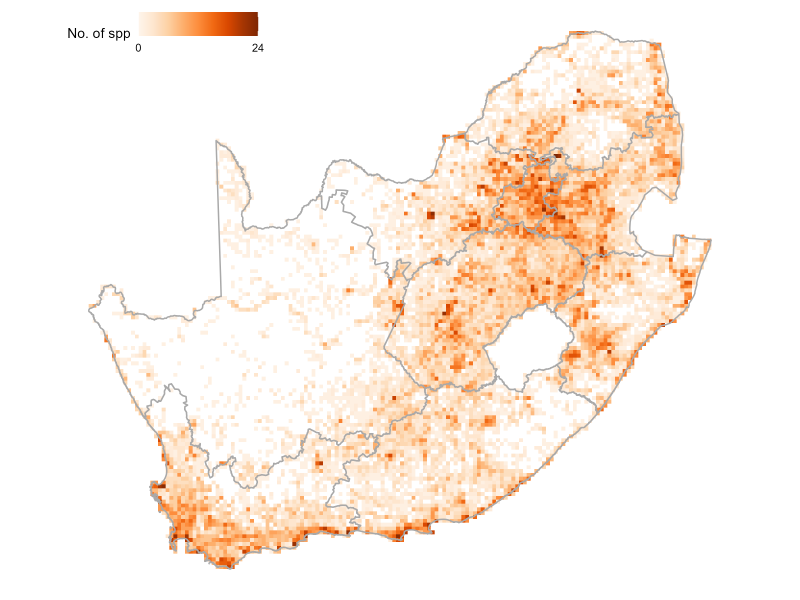
- Pressures
This assessment suggests agriculture and aquaculture are the dominant threat to South African birds, representing 63% of cumulative pressure—nearly double the impact of natural system modifications at 43%. The agriculture category encompasses three critical sub-pressures: wood and pulp plantations contributing 24%, annual and perennial non-timber crops at 23%, and livestock farming at 16%. These findings reflect South Africa’s extensive agricultural transformation, particularly in grassland and fynbos biomes. Grassland species such as Botha’s and Rudd’s Larks (Heteromirafra ruddi), Blue Swallow (Hirundo atrocaerulea), African Grass Owl (Tyto capensis) and Denham’s Bustard (Neotis denhami) are under extreme pressure with declining populations, while plantations similarly affect forest species such as Cape Parrot (Figure 5).
Botha’s Lark and Lappet-faced Vulture (Torgos tracheliotos) were uplisted to Critically Endangered (CR). Their key threats, habitat loss and poisoning respectively, are well understood, and urgent conservation action is essential to prevent their extinction
Natural system modifications, the second-largest threat, primarily involve ecosystem alterations and fire suppression regimes that disrupt natural habitat dynamics.
Waterbirds are particularly vulnerable to natural system modification, in addition to pollution of wetlands and waterways, with Mangrove Kingfisher (Halcyon senegaloides) being a notable example of a species undergoing declines (Figure 5). The decline of waterbirds not previously considered threatened is particularly concerning, though unsurprising given the poor state of freshwater habitats. These habitats are highly vulnerable to pollution, invasive species, siltation, and extreme weather. Improving freshwater health will require significant political will and resources. Freshwater species also face added risks because many are congregatory, making them prone to disease outbreaks. Greater protection of key sites is needed to prevent accelerated declines, while urban freshwater systems present opportunities for citizen-led restoration and monitoring.
Climate change emerges as the third major pressure at 30%, driven predominantly by habitat shifting and alteration as species distributions respond to changing climatic conditions.
Notably, biological resource use—primarily hunting and collecting terrestrial animals—accounts for 24% of pressure, while human development pressures including residential and transportation infrastructure collectively represent 28% of threats. The data aggregation reveals that while individual sub-pressures may appear manageable, their cumulative impact within broader pressure categories creates substantial conservation challenges requiring integrated landscape-scale management approaches. Scavenging birds such as vultures and Tawny Eagle (Aquila rapax) are experiencing rapid declines due to poisoning and persecution (Figure 5).

Protection level
To measure protection status, BirdLife South Africa applied two complementary approaches: a subpopulation-based method covering 667 terrestrial bird species, and a population-based method applied to 130 Red List species with available abundance estimates. (see approach below). The subpopulation approach confirms that most birds are spatially well represented within the protected area network, with over 84% classified as “Well Protected” in both 2017 (84.1%) and 2025 (84.9%), in broad agreement with the Retief and Marnewick (2017) study. Between 2017 and 2025, mean Protection Level scores increased from 7.50 (±0.32 SE) to 8.53 (±0.35 SE), representing a 13.7% increase, although only nine species (1.3%) showed improved protection categories between assessment periods – most gains were for species of low conservation concern.
The population-based analysis paints a more sobering picture, revealing that only 10% of threatened species meet minimum viable population thresholds inside protected areas. However, there was a positive movement to improved category status from 2017 to 2025: 123 of the 130 red list species did not reach the ‘well protected’ category in 2017, compared to 117 for 2025, representing an improvement of 4.6%. Together, these results highlight both the conservation value of South Africa’s protected areas and the gaps that remain, particularly for threatened, range-restricted and habitat-dependent species that require targeted expansion and improved management of the network (Lee and Ehlers Smith 2025).
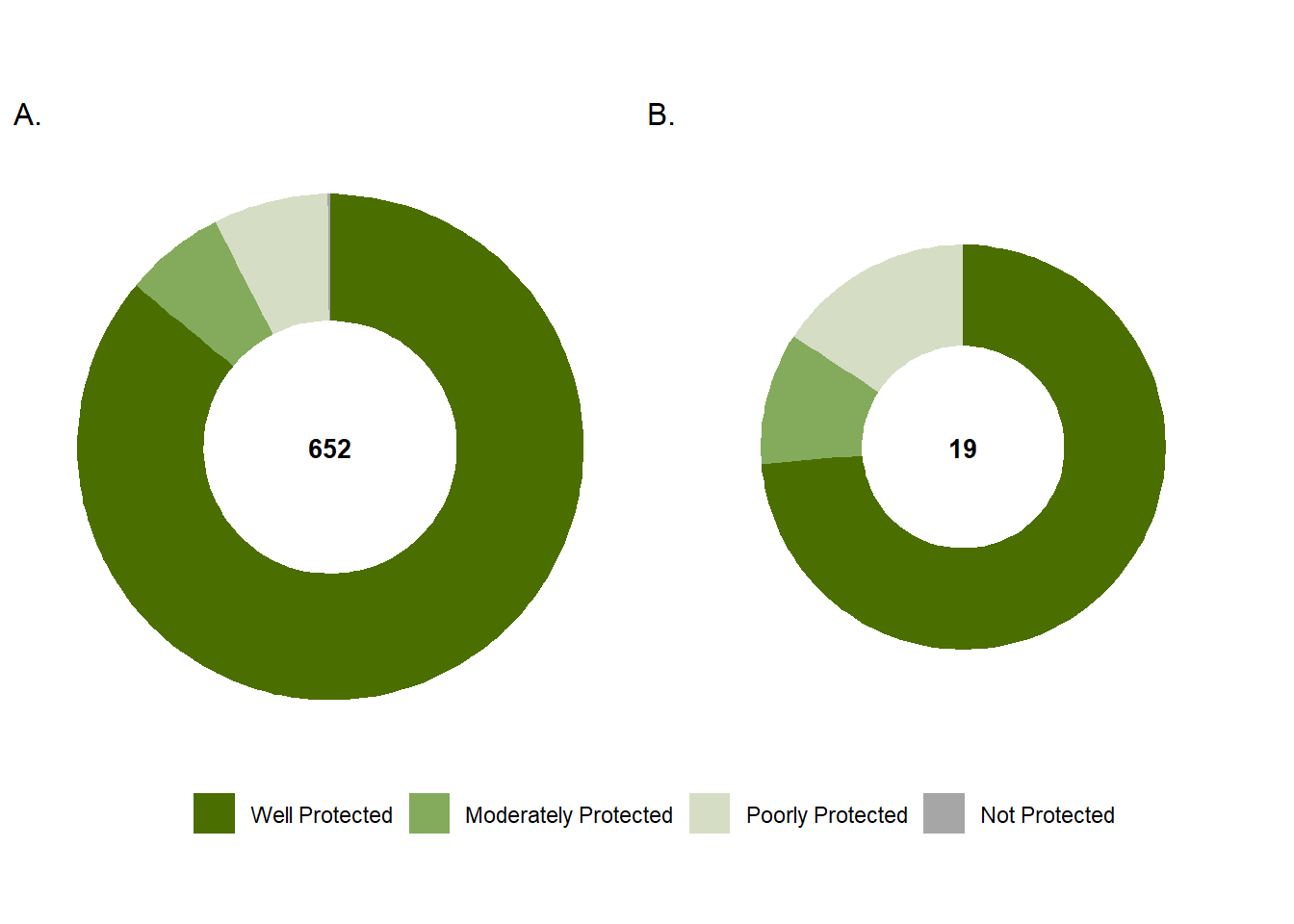

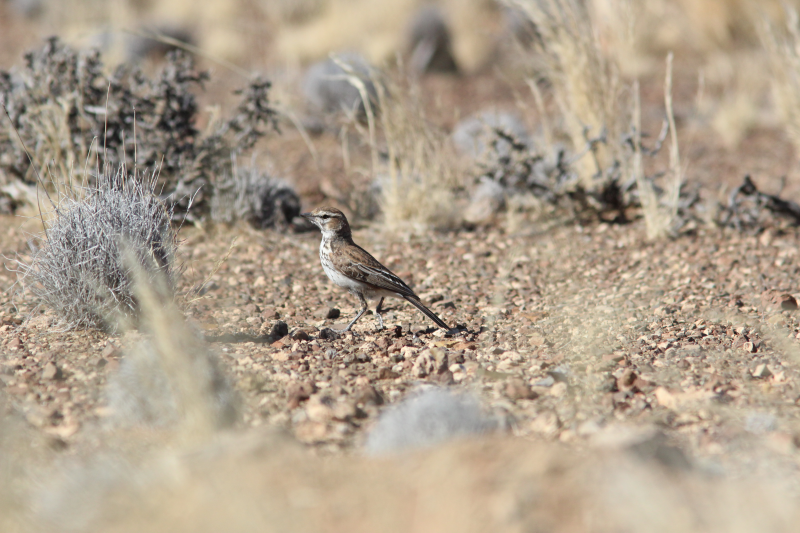
Species recovery
Despite South Africa’s extensive protected area network, many bird species remain at high risk of extinction because they face pressures that persist even when habitat is nominally safeguarded. Large birds, including vultures and storks, are prime examples. Recovery interventions are therefore critical to prevent imminent extinctions and to reverse long-term declines. Birds requiring recovery action tend to fall into three groups: (1) highly range-restricted endemics whose tiny populations are declining faster than habitat loss alone can explain; (2) species exposed to direct anthropogenic pressures such as poisoning, fisheries interactions, or collisions with energy infrastructure; and (3) island or seabird populations threatened by invasive predators at breeding sites.
Priority areas for bird recovery are guided by the 2025 Red List assessments and subsequent expert consultations. These processes identified species whose continued declines are unlikely to be halted by protected area coverage alone, and which therefore require targeted interventions. While the expansion of protected and conserved areas under Global Biodiversity Framework (GBF) Target 3 is essential, recovery planning shows that protection alone is insufficient unless paired with targeted species-focused measures. Where published prioritization exists, such as the Biodiversity Management Plan for Vulturesd2024a? or the Mouse-Free Marion Project plans, these form the basis for coordinated action. In other cases, BirdLife South Africa and partners use a combination of Red List urgency, ecological feasibility, and opportunity for partnerships with landowners or government to determine priorities.
Selected active recovery projects are highlighted below (Table 4). This showcases both the diversity of interventions needed and the scale of resources required. Some species, such as Botha’s Lark, require stewardship agreements and changes in land-use practices to secure remnant grassland habitat. Others, such as the Blue Swallow, demand artificial nest-site provisioning and alien clearing in addition to site protection. For marine birds such as the African Penguin, population recovery hinges on fisheries reform, fishery closures around key colonies, and advocacy on threats such as ship-to-ship bunkering.
Several threatened vultures (White-backed, Lappet-faced, Hooded and White-headed Vultures) require landscape-scale threat reduction, including poison-response networks, regulation of traditional medicine markets, a change in the hunting culture for a preference for lead-based ammunition, and mitigation of electrocution and collision risks. In contrast, the Bearded Vulture recovery strategy combines in situ action with a long-term ex situ programme (“Bearded Vulture Captive Breeding Project”), where harvested eggs are raised in captivity and juveniles reintroduced. Species like the Black Harrier highlight the urgent need for collision mitigation at wind energy facilities, given population viability models showing extreme sensitivity to adult mortality.
On Marion Island, a suite of seabird species (including albatrosses, petrels, and prions) are threatened by invasive House Mice, which predate on chicks and even adults. Without eradication, local extinctions are predicted within a century. The Mouse-Free Marion Project, budgeted at over R560 million, represents the largest single bird recovery initiative underway in southern Africa. See marine bird page for further details.
Collectively, these examples illustrate that recovery work is expensive and long-term, with estimated costs for the next five years exceeding R695 million and current funding falling short by hundreds of millions. While interventions are in place for many species, most require upscaling if they are to prevent extinctions. Success will depend on strong partnerships among government, NGOs, researchers, landowners, and local communities, and on mobilising significant new resources to match the scale of the challenge, in alignment with global commitments such as GBF Target 3 (expansion and effective management of protected areas) and GBF Target 4 (halting species extinctions and promoting recovery).
| Species | Status | Key Recovery Needs | Current Interventions |
|---|---|---|---|
| Botha’s Lark | CR | Stewardship outside reserves; research into grazing impacts | Stewardship and landowner engagement (BLSA, EWT) |
| Blue Swallow | CR | Stewardship; artificial burrows; alien clearing | Stewardship and monitoring (BLSA, Conservation Outcomes) |
| White-backed Vulture | CR | Landscape-level poisoning prevention; population supplementation | EWT Vultures for Africa; BLSA lead ammo awareness |
| Lappet-faced Vulture | CR | Landscape-level poisoning prevention; population supplementation | EWT Vultures for Africa; poisoning intervention |
| Hooded Vulture | CR | Habitat protection; poisoning prevention | EWT Vultures for Africa; habitat and poisoning response |
| Bearded Vulture | CR | Captive breeding programme with egg harvesting; threat mitigation | Bearded Vulture Task Force, Bred-for-the-Wild project |
| African Penguin | EN | Fishery closures; colony stewardship; advocacy | Colony management, BMP-S, new De Hoop colony, advocacy |
| Bank Cormorant | EN | Research; colony stewardship | Linked to African Penguin work |
| Cape Gannet | EN | Colony stewardship; foraging management | Linked to African Penguin work |
| White-headed Vulture | EN | Landscape-level poisoning prevention; population supplementation | EWT Vultures for Africa; poisoning intervention |
| Black Harrier | EN | Collision mitigation at wind farms; habitat protection | Research and advocacy on renewable energy impacts |
| Marion Island breeding spp | Varies | Eradication of invasive mice at Marion Island | Mouse-Free Marion Project (BLSA, DFFE) |
Knowledge gaps
While many longstanding pressures on South Africa’s birds are well recognised, a number of emerging threats and uncertainties require urgent research attention.
Agriculture and expansion of croplands continues to be linked to biodiversity loss, but the dynamics of this have been poorly quantified. For example, the rapid expansion of shaded agriculture, where fruit orchards are increasingly sealed under giant greenhouse structures will likely have negative impacts on avian biodiversity. These prevent access to flowering trees by natural pollinators and may have cascading impacts on terrestrial biodiversity. Parallel to this, agrochemical use has grown substantially, yet its full impact on South African birds and other wildlife is poorly understood. In addition, the spread of novel crops, including genetically modified organisms introduced into new habitats, raises questions about long-term ecosystem impacts.
Climate change represents a cross-cutting pressure whose biodiversity impacts remain poorly quantified at the species level. Although broad projections suggest range contractions and distribution shifts for many taxa, very few South African birds have been assessed using bespoke best-practice models that integrate climatic, habitat and demographic data. This leaves major uncertainty about which species are most vulnerable, the likely magnitude of impacts, and where conservation interventions should be prioritised. Incorporating climate velocity, dispersal capacity, and habitat quality into future assessments will be critical to identify both high-risk species and potential refugia.
Energy demand is another fast-moving frontier. The growth of cryptocurrency mining and AI technologies is driving global electricity consumption, yet the scale and consequences for South Africa remain largely unquantified. At the same time, renewable energy developments, particularly the rapid rollout of wind energy projects in Mpumalanga and along the coast, pose escalating risks for birds and bats. Offshore wind is also emerging as a potential future pressure on marine biodiversity.
New biological challenges are also evident. The proliferation of novel diseases, often exacerbated by climate change and land-use shifts, poses unknown risks to terrestrial bird populations. Bush encroachment in the karoo, grasslands and savannas, inappropriate fire regimes, and habitat fragmentation continue to alter habitat quality for specialist species. Illegal ploughing and clearing of natural habitats remain a widespread challenge, often circumventing environmental impact assessments.
Marine and coastal systems face their own suite of emerging pressures. Sardine stocks remain depleted, yet sardines are a keystone prey resource for seabirds and other predators; current operational management procedures inadequately account for ecosystem needs. Coastal aquaculture, including reliance on fishmeal and bonemeal inputs, has ecological knock-on effects that are poorly quantified. Sand mining is expanding along the east coast, threatening coastal biodiversity. Meanwhile, ship-to-ship bunkering operations, paused off Algoa Bay but likely to increase elsewhere, introduce additional risks of oil spills, noise pollution, and chronic disturbance in sensitive seabird areas.
Addressing these gaps will require both targeted research and systematic integration of new pressures into future Red List and protection level assessments. Improved data on novel threats, particularly energy infrastructure, agrochemical exposure, and marine resource exploitation, will strengthen conservation planning and ensure that the National Biodiversity Assessment reflects the full scope of pressures shaping South Africa’s birdlife.
Aknowledgement
Coordinated by:
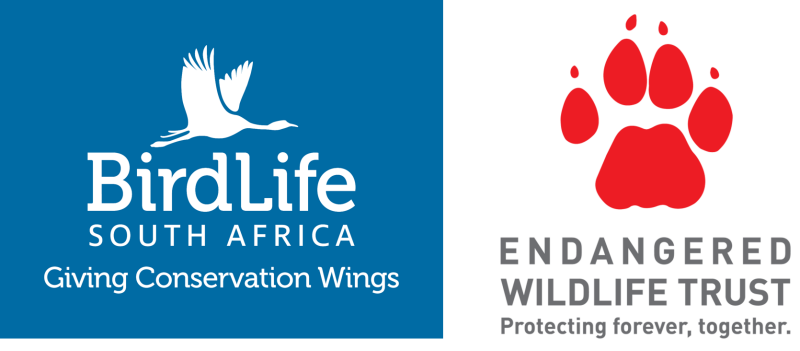
Sponsored by:
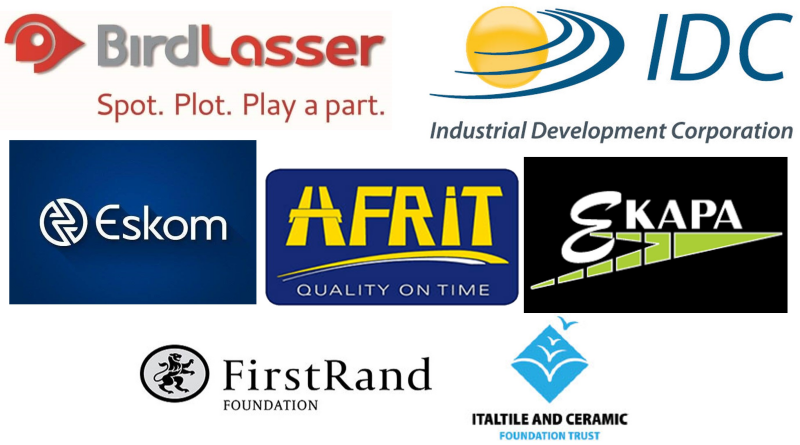
| Contributor | Affiliation |
|---|---|
| Hanneline Smit-Robinson | Birdlife South Africa |
| Chris Kelly | Wildlife ACT |
Approach
Threat status
The Regional Conservation Assessment for the birds of South Africa, Lesotho, and Eswatini was conducted by BirdLife South Africa with contributions from 138 species experts. It was initiated in late 2021, and assessments concluded at the start of 2025. This assessment builds upon the 2015 Eskom Red Data Book findings. All of Southern Africa’s non-vagrant species were assessed for signs of decline using citizen science datasets such as SABAP2, CWAC and CAR3. Taxon experts conducted assessments, updating assessments conducted in 2015 and conducting new ones for newly identified species (See Regional Red List of Birds of South Africa, Lesotho and Eswatini here - https://www.birdlife.org.za/red-data-book/ ).
Species deemed vagrants or introduced to the assessment region were excluded. At least 5% of a species’ global population or distribution needed to fall within the region to qualify for an assessment. We used as a starting point BirdLife South Africa’s Checklist of South Africa’s birds for 2023. This lists 876 species, but 123 were vagrant and 10 introduced. Introduced and vagrant species are not assessed during the Red Listing process, leaving 753 species. The taxonomy followed is that of the IOC World Bird Listgill2024a?. During 2023, a focus was on assessing Seabird species, for which there are few public datasets available, and where assessments rely heavily on expert knowledge. In 2023, a comprehensive synthesis of citizen science datasets for terrestrial (including freshwater) bird species was undertaken and these datasets fed the 2024 assessments of terrestrial and freshwater birds3 4. The thresholds and methods follow IUCN Global and Regional Red List guidelines and take into account new data on distribution, population trends, and known threats (IUCN Red Listing process summary here).
Protection level
Protected areas are the backbone of biodiversity conservation in South Africa. To measure protection status, BirdLife South Africa first piloted a species-level Protection Level (PL) metric in 2017, measuring the number of viable bird subpopulations occurring in well-managed protected areas (Retief and Marnewick 2017). Species occurring in >20 protected areas were deemed to be well protected. The method was refined for the current National Biodiversity Assessment (NBA) using improved spatial data, updated land-cover information, and a cluster-based definition of subpopulations, with >10 subpopulations required in protected area clusters. This framework allows a systematic comparison between 2017 and 2025, providing an evidence-based measure of how effectively the protected area network supports the long-term persistence of South Africa’s avifauna4.
Data source
Recommended citation
Lee, A., Smith, D.E., Raimondo, D.C., Van Der Colff, D., Hendricks, S.E., & Lloyd, K. 2025. Birds. National Biodiversity Assessment 2025. South African National Biodiversity Institute. http://nba.sanbi.org.za/.
